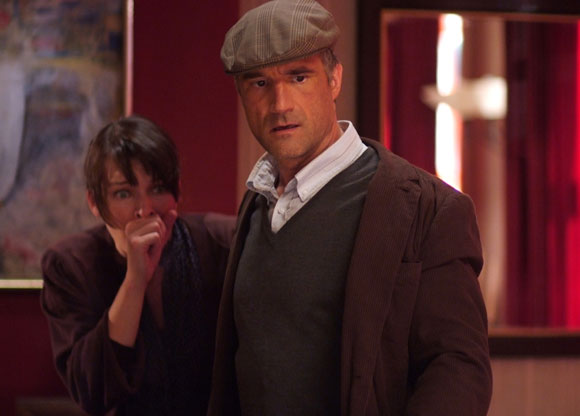The Fourth Kind

It’s 12:36 a.m. My attention is frantic. The position of my eyes are torn between the computer screen of my Macbook Pro, The Nanny on the television to my right, and the single small flickering light in the sky I see outside my window of my North Philadelphia dorm room. I walked out of Olatunde Osunsanmi’s The Fourth Kind roughly forty minutes ago. I remember procrastinating, going back to my dorm by hanging out with a friend next to a billboard just outside the theater. I think I’ve finally experienced that feeling my father felt in 1979 after he left The Exorcist.
The film opens with Ukranian actress Milla Jovovich introducing herself and that she will be playing Dr. Abigail Tyler, a psychologist based in Nome, Alaska. We are then introduced to footage of the real Dr. Abigail Tyler, a thin, ghostly-woman that bares no real resemblance to Jovovich. Her appearance is haunting. She is pale, sits perfectly upright in her chair, and has enormous eyes that are sunken into her face that are complimented by dark lines that almost seem to hold them there. Tyler is being interviewed by Osunsanmi at a lecture in Chapman University in Orange, California.
Her discussion with Osunsanmi allow the filmmaker to recreate events that bridge pieces of archive footage taken during Tyler’s study in Nome. A small handful of the citizens of Nome have reported irregular sleep habits and seeing a strange white owl outside their window. When we experience the hypnosis sessions of Tyler, they are a combination of both the reenactments and existing footage of what is supposed to be patients suffering repercussions from being abducted by extra terrestrials. The results are often very frightening.
It is interesting to see how the efforts of a filmmaker and his creative team try to compete with actuality. A filmmaker has the ability to suspend disbelief, mold emotion, and evoke things we thought we could never feel. The filmmaker does all this by simply manipulating the plastic elements to his liking. He is giving reality a creative treatment. Now in this film, the reenactment footage is placed side by side with the archival footage. This is a mistake.
The hand-held filmed re-enactments lacking, I found myself riveted by the incorporated actual footage. If the filmmakers believe they can truly evoke an emotional response from the audience by having their “new-and-improved” product side by side with what is real, then their heads are bigger than the hype for Paranormal Activity. As the film progresses, the archive footage dominates.
I honestly believe that Osunsanmi has pulled out the rug underneath himself. The audience is expected to look here, look there. Be frightened by this, but let that frighten you more. Turn on your fiction switch, turn it off. Turn on your reality switch. The catharsis between film and viewer is not something to be tossed back and forth like a bunch of hipsters playing hacky-sack. We know what’s real and what’s not. That’s why The Fourth Kind renders its own original material completely worthless.
A majority of the shots within the fiction of the film are just dramatically lit hand-helds—distractingly shaky—and some tracking shots that frame Tyler’s Range Rover as if we’re watching a commercial for the product. The performances themselves are fine, but fall very short of mind-blowing.
Did the filmmakers possess so little confidence in the archival material that they believed dramatically lit talking heads would please the audience more? I don’t know. I don’t want to know.
Even so, the film is watchable. The real footage is quite scary. It could have been something even more frightening and powerful if allowed to stand on its own, in raw form. And even if all the footage is a complete hoax, that just tells you they put too much effort in the wrong place.
 The Fourth Kind • Dolby® Digital surround sound in select theatres • Aspect Ratio: 1.85:1 • Running Time: 98 minutes • MPAA Rating: PG-13 for violent/disturbing images, some terror, thematic elements and brief sexuality. • Distributed by Universal Pictures
The Fourth Kind • Dolby® Digital surround sound in select theatres • Aspect Ratio: 1.85:1 • Running Time: 98 minutes • MPAA Rating: PG-13 for violent/disturbing images, some terror, thematic elements and brief sexuality. • Distributed by Universal Pictures